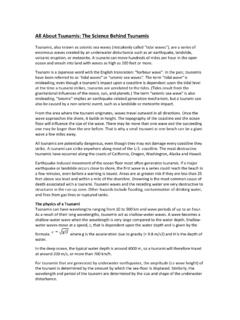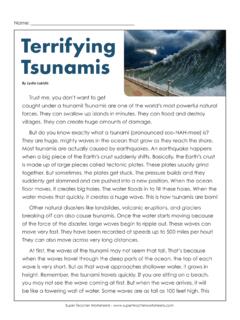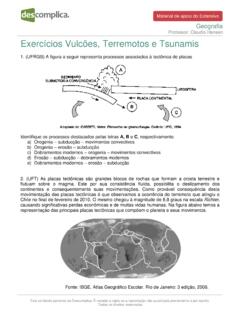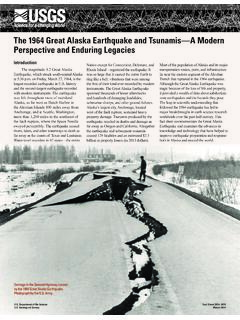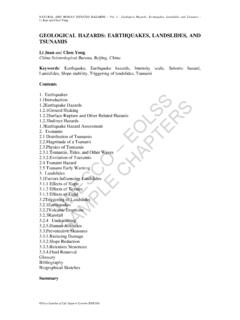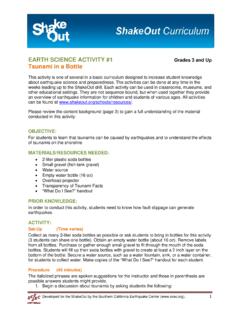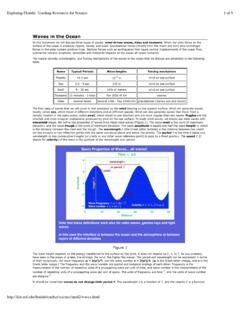Transcription of Geologic Hazards: Risks and Mitigation
1 CHAPTER 8: Geologic hazards 131 CHAPTER 8 Geologic hazards : Risks and Identifying and Profiling Geological hazards Assessment of Local Geological hazards Vulnerability and Potential Losses Assessment of State Geological hazards Vulnerability and Potential Losses Geological hazards Mitigation Efforts132 UTAH STATE HAZARD Mitigation Identifying and Profiling Geological hazards Geologic hazards are those Geologic conditions that present a risk to life (injury or death), of substantial loss or damage to proper-ty, or damage to the environment. Geologic hazards affect Utah, negatively impacting life safety, health, property, and the state s economy. For the purpose of this Mitigation plan, the term geological hazard is used to describe earthquake hazards (ground shaking, surface fault rupture, and liquefaction), landslide hazards (landslide and rockfall), problem soil and rock hazards , and volcanic hazards (volcanoes and eruptions).
2 Major Geologic hazard events in the past five years include a fatal rockfall in Rockville, Washington County on December 12, 2013, the Parkway Drive landslide in North Salt Lake, Davis County on August 5, 2014, the 2017 flooding and landslides in Box Elder County, and the 2017 Spring Creek Road landslide in Riverdale, Weber County. While many Geologic hazards are not life threatening, they are often costly when not recognized and properly accommodated in land-use management and project planning and design, and result in additional, significant construction or future maintenance costs, economic losses, and injury or death. There is only limited information on the direct and indirect economic costs of Geologic hazards in the , including Utah; however, some information is available for large landslide events. Landslides in the United States caused between $ and $ billion in damages each Since 1847, at least 6075 deaths, as well as a significantly larger, but undetermined number of injuries and an undetermined finan-cial cost, have been attributed to Geologic hazards in Utah.
3 Radon gas exposure causing lung cancer has been Utah s most deadly Geologic hazard, with over 5630 fatalities (data only available from 1973 to 2015), followed by landslide hazards with 342 docu-mented fatalities and flooding hazards accounting for 101 documented fatalities. As debris flows are both a landslide and flooding hazard, fatalities are listed in both hazard categories. Using the economic value of a statistical life of $ million, the 6075 fatalities are valued at $ trillion (2017 dollars). Radon-gas-related human treatment costs are large as well. For a 72-year old diagnosed with lung cancer in 2000, the cost of the first six months of care ranged from $16,122 (no active treatment) to $56,160 (chemo-radiotherapy) and varied by stage at diagnosis and histologic This does not include ongoing treatment or end-of-life care, often the costliest. Table 1.
4 Summary of known Geologic -hazard fatalities in Utah (1847 to 2019) Geologic HazardFatalities1 Because of uncertainty in event initiation, three fatalities are listed in both the Landslides and Dam and Water Conveyance Structure Failure Debris flows are both a landslide and flooding The majority of post-1950 snow avalanche fatali-ties are in the backcountry from human-induced avalanches; however, many have occurred near or in developed areas where appropriate Mitigation measures should be Limited data are available and contain various as-sumptions; exact number of fatalities is HazardsGround Shaking2100%2< and Water Conveyance Structure SoilsRadon Gas41973-20155630100% :60751 Committee on Ground Failure hazards , 19852 Cipriano and others, 2011 CHAPTER 8: Geologic hazards 133 Damages as the result of many Geologic hazards are often not covered by property or other insurance.
5 There are exceptions and each policy should be reviewed for what damages are covered or excluded. Homeowners property policies generally cover all- Risks or perils (property losses and damages), except for those specifically excluded. Common exclusions are damages from earth movements, earthquakes, mudflows, mine subsidence, sinkholes, flooding, and environmental factors. Special policies may be available to cover specific named perils. Homeowners may be able to get cov-erage for generally excluded losses by adding them to an existing policy by endorsement or by the purchase of a separate policy. A difference in conditions policy provides coverage for some otherwise excluded perils and is also known as a catastrophe policy. Multiple types of commercial property policies are available; however, earth movements such as earthquakes, mudflows, mine subsidence, sinkholes, and flooding are commonly excluded.
6 Endorsements can typically be added to a policy to provide coverage for these perils and for expanding coverage for other perils. Commercial auto policies have more options available and coverage must be specified for each vehicle or type of vehicle. Dam-ages from Geologic hazards may or may not be covered, depending on the policy. Personal auto policies generally cover all- Risks or perils, including Geologic hazards , such as earthquakes, flooding, falling objects, volcanic eruptions, etc. for individuals with collision and comprehensive coverage. In almost all cases, it is more cost-effective to investigate and characterize potential hazards by performing a comprehensive engineering-geology investigation to identify and characterize Geologic hazards and implement appropriate Mitigation , rather than relying on additional maintenance over the life of a project or incurring costly construction change orders and other financial costs.
7 The Utah Geological Survey (UGS) recommends living with and managing Geologic hazards by understanding what they are, where they exist, how large or difficult they are, and how to effectively mitigate them. To ensure that future development within Utah is protected from Geologic hazards , the UGS recommends that a comprehensive engineering-geology and geotechnical engineering investigation be performed by licensed professionals for all development. Such investigations provide valuable information on site Geologic conditions that may affect or be affected by development, as well as the type and severity of Geologic hazards at a site and recommend solutions to mitigate the effects and the costs of the hazards , both at the time of construction and over the life of the development. Engineering-geology investigations and accompanying geo-logic-hazard evaluations may be performed independently or be included as part of a more broadly-based geotechnical investiga-tion before project engineering design.
8 Much of this chapter has been derived from the Utah Geological Survey (UGS) Circular 122: Guidelines for Investigating Geo-logic hazards and Preparing Engineering-Geology Reports with a Suggested Approach to Geologic -Hazard Ordinances in Utah publication available at As the UGS revises or develops new geolog-ic-hazard guidelines, Circular 122 will be updated as appropriate. Refer to the URL link above for the most recent Geologic hazard investigation and report guidelines and related information. Geologic HAZARDSG eologic hazards are defined in Utah Code as a Geologic condition that presents a risk to life, of substantial loss of real property, or of substantial damage to real property (Title 17, Chapter 27a, Section Geologic hazards commonly encountered in Utah include, but are not limited to:Earthquake (Seismic) hazards , including: Earthquake ground shaking Surface fault rupture (faults) Liquefaction Seiche3 tsunami Tectonic deformation Earthquake-triggered landslides and rock fall134 UTAH STATE HAZARD Mitigation PLANL andslide hazards , including: Landslides Rock fall Debris flows Snow avalanches (covered in the Other hazards section)Flooding hazards , including.)
9 River, lake, or sheet flooding (covered in the Flooding hazards section) Debris flows Dam and water conveyance structure failure (covered in the Flooding hazards section) Seiches Tsunamis Shallow GroundwaterProblem Soil and Rock hazards , including: Breccia pipes and karst Caliche Collapsible soils Corrosive soil and rock Expansive soil and rock Gypsiferous soil and rock Land subsidence and earth fissures Piping and erosion Radon gas Salt tectonics Shallow bedrock Wind-blown sandVolcanic hazards , including: Volcanic eruption Lava flows Airborne volcanic ashEARTHQUAKE (SEISMIC) HAZARDSAn earthquake occurs when two blocks of the earth suddenly slip past one another, releasing built up energy from plate tecton-ics, regional stress regimes, and induced from fluid injection or underground mining activities. The surface between these two blocks is called a fault or fault plane.
10 When these blocks move, they produce seismic waves that are transmitted outward through the rock in all directions, producing ground shaking and secondary effects. Earthquakes are unique multi-hazard events with the potential to cause very large damages and loss of life. Earthquake secondary effects often include surface fault rupture (generally magnitude [M] ), liquefaction and lateral spreading can be triggered as low as approximately Landslides, rock fall (generally M 4), tectonic subsidence, seiches and tsunamis. Effects from ground shaking may include building and infrastruc-ture damage, fires, building and dam and canal failure, hazardous material releases, and non-structural building damage such as toppled cabinets, bookcases, and other furniture or equipment that was not restrained, falling ceiling tiles, lights, and other ceiling mounted items, and movement of unrestrained furniture, equipment and other building interior items.
